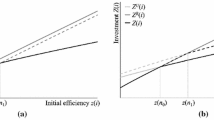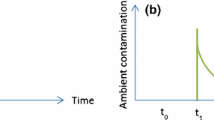Abstract
Environmental mandates can impose large costs on the businesses that must comply with them. Understanding the effects of those costs on production decisions may require a dynamic framework if environmental damages (and the costs of complying with mandates) depend on cumulative production or the passage of time. This paper focuses on the time dimension of general categories of fixed and variable costs arising from different types of mandates. The paper develops an optimal control model to predict how such costs may jointly affect current production rates, plant closure dates, and cumulative production. Theoretical results, derived from the comparative statics of the system of equations describing the solution to that model, identify circumstances in which the policy goals of greater production and greater environmental protection may not allways be at odds.
Similar content being viewed by others
References
Cropper, M. L. and W. E. Oates (1992), ‘Environmental Economics: A Survey’,J.E.L. 30, 675–740.
Conrad, R. F. and B. Hool (1981), ‘Resource Taxation with Heterogeneous Quality and Endogenous Reserves’,J. Publ. Econ. 16, 17–33.
Deily, M. E. and W. B. Gray (1991), ‘Enforcement of Pollution Regulations in a Declining Industry’,J. Environ. Manag.,21(3), 260–274.
Griffin, J. M. (1988), ‘A Test of the Free Cash Flow Hypothesis: Results from the Petroleum Industry’,Rev. Econ. and Statis. 70(1), 76–82.
Heaps, T. (1985), ‘The Taxation of Nonreplenishable Natural Resources Revisited”,J. Environ. Econ. Manag. 3(1), 14–27.
Hubbard, R. G., A. K. Kashyap, and T. M. Whited (1993), ‘Internal Finance and Firm Investment’, National Bureau of Economic Research, Inc., Working Paper No. 4392.
Kamien, M. I. and N. L. Schwartz (1978), ‘Optimal Exhaustible Resource Depletion with Endogenous Technical Change’,Rev. Econ. Studies 45(139), 179–196.
Kamien, M. I. and N. L. Schwartz (1981),Dynamic Optimization: The Calculus of Variations and Optimal Control in Economics and Management, North Holland, New York.
Levhari, D. and N. Liviatan (1977), ‘Notes on Hotelling's Economics of Exhaustible Resources’,Canad. J. of Econ. 10(2), 177–192.
Markusen, J. R. (1996), ‘Costly Pollution Abatement, Competitiveness, and Plant Location Decisions’, National Bureau of Economic Research, Inc., Working Paper No. 5490.
Milliman, S. R. and R. Prince (1989), ‘Firm Incentives to Promote Technological Change in Pollution Control’,J. Environ. Econ. Manag. 17, 247–265.
Peterson, F. M. (1978), ‘A Model of Mining and Exploring for Exhaustible Resources’,J. Environ. Econ. Manag. 5(3), 236–251.
Pindyck, R. S. (1980), ‘Uncertainty and Exhaustible Resource Markets’,J.P.E.,88(6), 1203–1225.
Schulze, W. D. (1974), ‘The Optimal Use of Non-Renewable Resources: The Theory of Extraction’,J. Environ. Econ. Manag. 1(1), 53–73.
van der Ploeg, F. and C. Withagen (1991), ‘Pollution Control and the Ramsey Problem’,Environmental and Resource Economics 1(2), 215–236.
Author information
Authors and Affiliations
Additional information
Statements in this paper do not reflect the views or positions of the Congressional Budget Office
Rights and permissions
About this article
Cite this article
Farmer, R.D. Intertemporal effects of environmental mandates. Environ Resource Econ 9, 365–381 (1997). https://doi.org/10.1007/BF02441405
Accepted:
Issue Date:
DOI: https://doi.org/10.1007/BF02441405




